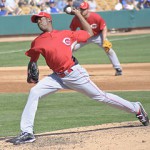Thanks to Rob Neyer, who pointed out this interesting study done at BaseballAnalytics.org by writer David Golebiewski, which showed how the faster the fastball, the LESS likely it was to be called a strike for “in-zone” pitches. And its a significant margin (see the link for the percentages): a guy who throws 86-88mph gets nearly 10% more called strikes within the zone than a guy who throws 98mph.
That’s amazing.
The called-strike rate is also larger for out-of-zone strikes for softer-tossing pitchers, by about a 5% margin. And to further add insult to injury, the missed strikes are more prevalent to left-handed hitters than to righies.
Both Neyer and Golebiewski imply that the reason for this phenomena is physical limitations in the Umpire, who struggles to “see” a 98mph fastball and thus misses it. This leads (in comments sections) to inevitable calls for automated strike zones and the use of pitch f/x instead of humans.
I have a possible different theory; one that any of us that play amateur baseball can readily attest to; I believe that in the amateur game (whether it be little league or adult amateurs) a guy who throws harder is naturally given a smaller zone, while a softer-tossing guy generally gets a larger zone. Not because the umps can’t see the ball, but because umps make the assumption that velocity equates with talent, and thus give the softer-tossing guy more benefit of the doubt when it comes to the strike zone.
Thoughts? Maybe Mike Rizzo shouldn’t be spending as much time filling his rotation with power arms, if they have smaller strike zones as a result. Or, more to the point, maybe this is all the argument we need to give Henry Rodriguez his walking papers.

Todd – this stuff is pretty remarkable, I agree. Pitch FX, and now Field FX, are going to make all this stathead analysis over the next 10 years or so provide even more insight, and I think the move to some automation in how calls are made is inevitable.
To make sure that I understand your point, was your theory that the ump thinks the soft tosser is a lesser talent, and therefore intentionally calls more strikes for him to help him out (or maybe subconsciously)? I could see that in games involving younger kids, but have a hard time believing that makes its way into the pro game. I’d be more inclined to go with Neyer’s view that the added velocity makes it harder for umpires to track close calls accurately.
Here is another similar kind of article specifically about Masterson. It is the other side of the same coin, namely pitch framing by catchers. But this also seems like an area ripe for more learning in the next few years.
http://www.fangraphs.com/blogs/index.php/how-much-better-could-justin-masterson-be/
Wally
28 Feb 13 at 2:26 pm
The stats were pretty startling and distinct (a 10% difference is massive), so there has to be a reason. Do we believe that umpires just can’t track the pitched ball at those speeds and thus “miss” them? That’s the theory of the article. I don’t buy it. I umpired when i was younger; you’re right there. It isn’t as if catchers have a harder time catching faster fastballs .. why do we think umpires miss them?
Pitch framing is another debatable topic, worthy of a whole other discussion. How much value does pitch framing have? I go back to my own experiences umpiring; i didn’t even look at wherever the catcher caught hte ball; i watched the flight in and made my determination based on where the ball crossed the plate. Why isn’t this what happens in professional leagues?
Todd Boss
1 Mar 13 at 2:01 pm
I think umpire limitations are the problem, but I have a different take on this. A blazing fastball is clearly harder to judge when it crosses the plate. But the other factor is umpire expectations. Soft tossers are control pitchers who are rewarded by umps for their ability to hit their spot–those who can’t are called “minor leaguers” Umps really like pitchers who hit the mitt framed by the catcher. Most hard throwers–and their are many in the majors–tend to be wilder, and umps obviously know this and will not give them the close calls as much. By the way, these “really hard throwers” with good control are known by their other name, “all stars.”
Myrubberarm
1 Mar 13 at 5:20 pm
Good point. Here’s a follow-up question; why do umpires depend (or even look at) where a catcher catches the ball? Why aren’t they looking at what they should be looking at; where the ball is when it crosses the plate and making a judgement at that point on whether or not the pitch is a strike. Even if a guy is throwing with a ton of movement, the delta a ball can move between the time it crosses the plate and the time it is caught by the catcher (a distance of no more than 2 feet) has to be miniscule enough to not make a difference one way or the other. This takes me back, again, to my own umpiring days; I could care less where the catcher caught the ball; it was where the ball crossed the plate.
Todd Boss
4 Mar 13 at 11:51 am